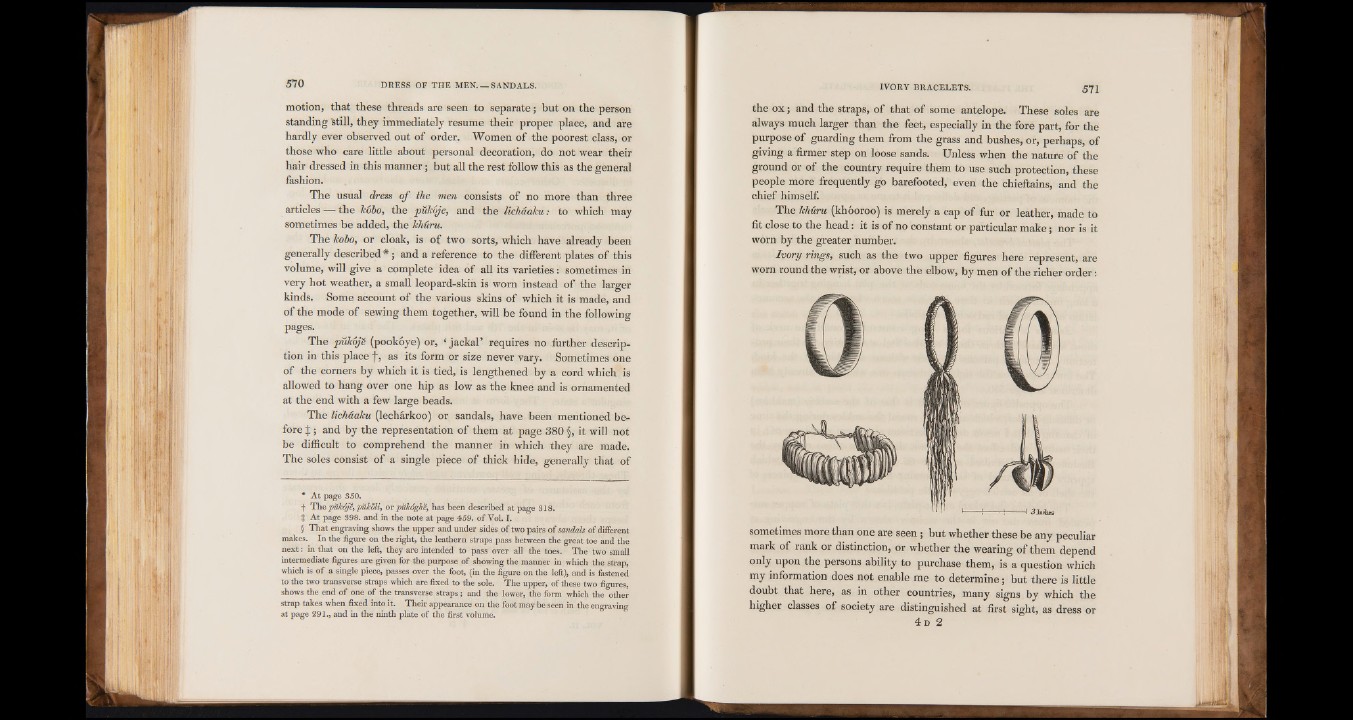
motion, that these threads are seen to separate ; but on the person
standing Still, they immediately resume their proper place, and are
hardly ever observed out of order. Women of the poorest class, or
those who care little about personal decoration, do not wear their
hair dressed in this manner ; but all the rest follow this as the general
fashion.
The usual dress of the men consists of no more than three
articles — the hobo, the pukoje, and the lichâaku : to which may
sometimes be added, the khuru.
The kobo, or cloak, is of two sorts, which have already been
generally described*; and a reference to the different plates of this
volume, will give a complete idea of all its varieties : sometimes in
very hot weather, a small leopard-skin is worn instead of the larger
kinds. Some account of the various skins of which it is made, and
of the mode of sewing them together, will be found in the following
pages.T
he p ukbfé (pookoye) or, * jackal’ requires no further description
in this place f, as its form or size never vary. Sometimes one
of the corners by which it is tied, is lengthened by a cord which is
allowed to hang over one hip as low as the knee and is ornamented
at the end with a few large beads.
The lichâaku (lechârkoo) or sandals, have been mentioned before
$ ; and by the representation of them at page 380 §, it will not
be difficult to comprehend the manner in which they are made.
The soles consist of a single piece of thick hide, generally that of
* At page 350.
f The •puk6jei -puJcoli, or pUkdghe, has been described at page 318.
$ At page 398. and in the note at page 459. of Vol. I.
§ That engraving shows the upper and under sides of two pairs of sandals of different
makes. In the figure on the right, the leathern straps pass between the great toe and the
next: in that on the left, they are intended to pass over all the toes. The two small
intermediate figures are given for the purpose of showing the manner in which the strap,
which is of a single piece, passes over the foot, (in the figure on the left), and is fastened
to the two transverse straps which are fixed to the sole. The upper, of these two figures,
shows the end of one of the transverse straps; and the lower, the form which the other
strap takes when fixed into it. Their appearance on the foot may be seen in the engraving
at page 291., and in the ninth plate of the first volume.
the o x ; and the straps, of that of some antelope. These soles are
always much larger than the feet, especially in the fore part, for the
purpose of guarding them from the grass and bushes, or, perhaps, of
giving a firmer step on loose sands. Unless when the nature of the
ground or of the country require them to use such protection, these
people more frequently go barefooted, even the chieftains, and the
chief himself.
The khuru (khooroo) is merely a cap of fur or leather, made to
fit close to the head: it is of no constant or particular make; nor is it
worn by the greater number.
Ivory rings, such as the two upper figures here represent, are
worn round the wrist, or above the elbow, by men of the richer order:
sometimes more than one are seen ; but whether these be any peculiar
mark of rank or distinction, or whether the wearing of them depend
only upon the persons ability to purchase them, is a question which
my information does not enable me to determine ; but there is little
doubt that here, as in other countries, many signs by which the
higher classes of society are distinguished at first sight, as dress or
4 d 2